Written by: Marge Vorndam, Native Plant Master
Xeriscape gardens are becoming more popular throughout Colorado and the West. As our populations and agricultural use increases, our traditional supplies of water diminish so being water- wise is a critical concern. But, having less water available doesn’t mean that we must give up landscaping around our homes. Instead, we can concentrate on the many beautiful dry-land plants that grow wild or are available to grow from similar climes in other places in our world. Additional value of doing this is that we also perpetuate the wildlife – birds, bees, butterflies, etc. that use these plants for forage and shelter.
In this article, I have chosen several of the more uncommon xeric perennial plants that can thrive in your home gardens. Some of these plants are not readily available in local nurseries, so you may need to use online web resources to locate these specimens. Many of these plants grow more readily from nursery stock rather than seeds. Please remember that it is illegal to dig specimens or collect seeds for domestic use from public lands.
Xeric plants thrive in rock gardens and graveled beds. They prefer full sun or minimally shady locations. Soil conditions are specified with each description below. Be sure not to overwater which can result in root rot. Seeds and nursery plants may require more water initially to establish a root base in your garden. The spreading types will help to prevent soil erosion on slopes.
These plants represent some of my favorite selections, so I am sharing them with you.
Most of the information featured here can be found in or is excerpted from
Denver Water, 1996. Xeriscape Plant Guide, Fulcrum Publishing, Golden, CO Also, check online sources for further information butterflies about these selections.
Field Trip Opportunities for More Ideas for Summer blooming dry-land plants:
Pueblo West Xeriscape Demonstration Garden
Pueblo River Walk
Southeastern Region Water Conservancy Xeriscape Garden
Conservation & Environmental Center-Colorado Springs Utilities
Featured Xeric Plants
Asclepias tuberosa – Butterfly Milkweed
Delosperma sp. – Ice Plant
Lithospermum incisum – Fringed Puccoon, Narrow-leaved Puccoon
Stanleya pinnata – Prince’s Plume
Sempervivium sp.- Hens & Chicks
Zinnia grandiflora – Golden-flowered Prairie Zinnia
Asclepias tuberosa – Butterfly Milkweed
Family Asclepiadaceae
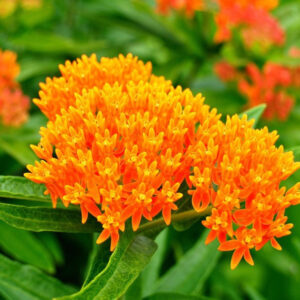
https://gardenforwildlife.com/products/orange-butterfly-milkweed-3-pack
Asclepias is widely native in grasslands across Midwest and Great Plains, including Colorado to 7,000 feet.
As common to most milkweeds, it is poisonous/toxic if ingested. Historical uses by Native Americans included the construction of rope, cloth, for food and medicinal applications.
This plant blooms in midsummer with flowers that are orange or yellow in a terminal cluster. Wildlife value includes attracting butterflies, ostensibly the diminishing Monarch population (Danaus plexippus). Plant sap ingestion by Monarch caterpillars protects them from predation.
Height of stems can be up to 35 inches with a mounding and spreading habit. Cubing back in fall will maintain shape as the plant Increases by underground roots and can be invasive.
Milkweed is easily propagated from seed and dormant rhizome cuttings. Seeds are wind-dispersed from pods in Fall.
Soil preference is sandy, loamy, and rocky limestone soils. It needs a maximum of 6 to 8 inches of water per year.
+++++
Delosperma sp.- Ice Plant
Delosperma is a genus of about 150 species in the family Aizoaceae.

D. “Fire Spinner” ® High Country Gardens
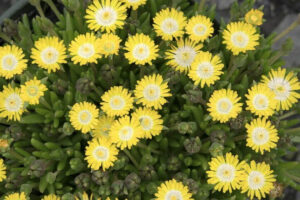
D. nubigum
Ice plant originated from South Africa. It has been naturalized to the US and will grow to an elevation of 6,000 feet in Colorado.
The variety of flower color varies widely, covering the rainbow spectrum. Ice plant blooms late Spring featuring 1.5-to-2-inch flowers. When not in bloom, the mat forming plants feature succulent cylindrical leaves that may change color with the seasons. It interfaces with wildlife through attracting butterflies, but it is deer and rabbit resistant. A popular species in Colorado is D. cooperi, a purple-flowered ice plant.
Size of plant varies by species. Landscape specimens grow to a height of up to 6 inches, spreading to 36 inches. It is desirable in places where a ground cover is preferable.
Ice Plant is adaptable to most well-drained soils including amended clay.
+++++
Lithospermum incisum – Fringed Puccoon, Narrow-leaved Puccoon
Family Boraginaceae
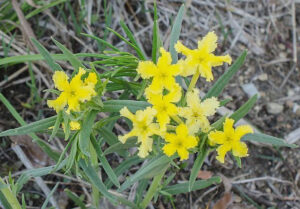
Bill Johnson (Copyright © 2014) https://www.illinoiswildflowers.info/prairie/plantx/fr_puccoon.html
Puccoon is native to Colorado Rocky Mountain Foothill grasslands and prairie grasslands in other states.
The plant blooms late spring to early summer. It’s unique bright yellow to orange-yellow fringed flowers vary from 1/2 to 1 inch wide on a slender one inch long tube. Stem height can reach 16 inches. It is often found in the wild in colony groupings.
Puccoon is used as a dye plant by Native Americans. It is adaptable to sandy-gravelly-stony types of soils.
+++++
Sempervivium species – Hens & Chicks
Family Crassulaceae
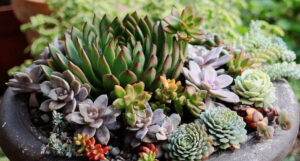
These unique species are native to Europe and Africa and have been naturalized to US. Plants are hardy to elevation of 8,000 feet in Colorado.
Sempervivium sp. blooms mid-Summer, but foliage of the succulent leaved rosettes is the draw and provides year-round interest.
Size varies by species. Plants are mat forming, growing from shoot “Chicks” which help to spread new plants from the parent “Hen”.
The plants are adaptable to most well-drained soils, particularly sandy-gravelly-stony types.
+++++
Stanleya pinnata – Prince’s Plume
Family Brassicaceae
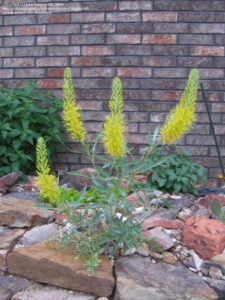
This plant is native to desert shrub communities in the Rocky Mountain Region. It grows well at elevations between 4,500 – 6,000 feet.
Stanleya blooms in May to August, featuring foot-long terminal racemes bearing spectacular yellow spider-like flowers. Stem height is up to 3 feet with a spread of 5 feet. Flowers attract butterflies and bees.
It prefers poor dry soils containing some amount of calcium.
+++++
Zinnia grandiflora – Golden Flowered Prairie Zinnia
Asteraceae Family
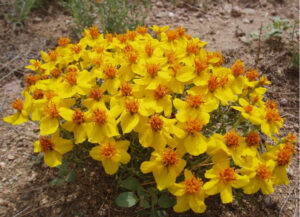
USDA – https://plants.ces.ncsu.edu/plants/zinnia-grandiflora/
This zinnia is native to Colorado, New Mexico, and Mexico. It grows well at elevations between4,000 to 6,000 feet.
It blooms May to October, featuring one-inch flowers that are yellow with orange anthers. When not in bloom, the plant appears as a mound of needle-like leaves. Stem height is 8 inches and plant spread can be 10 inches or more. Flowers attract butterflies, bees, and moths. The plant is deer and rabbit resistant. Lifespan is 2 to 3 years, but this plant propagates new growth from rhizomes.
It prefers amended clay to sandy soils. Don’t overwater, but it does needs up to a maximum of 6 to 8 inches per year.
Uses by Native Americans traditionally include ceremonial and medicinal applications.


